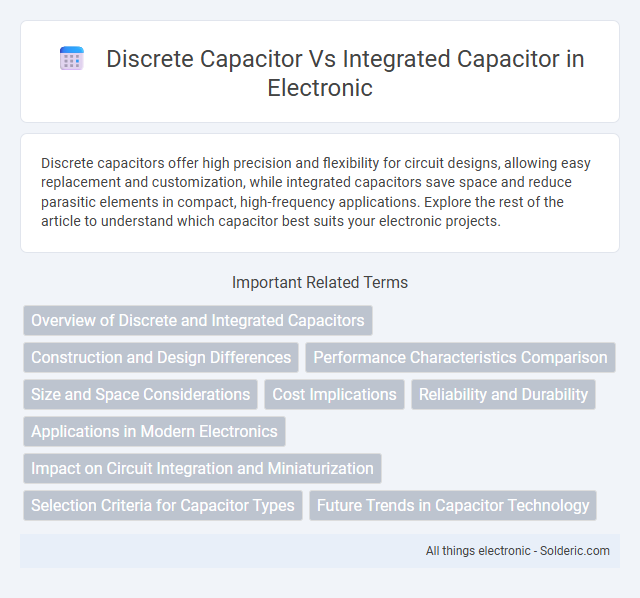Discrete capacitors offer high precision and flexibility for circuit designs, allowing easy replacement and customization, while integrated capacitors save space and reduce parasitic elements in compact, high-frequency applications. Explore the rest of the article to understand which capacitor best suits your electronic projects.
Comparison Table
| Aspect | Discrete Capacitor | Integrated Capacitor |
|---|---|---|
| Definition | Standalone capacitor component soldered onto PCB | Capacitor fabricated within an integrated circuit (IC) |
| Size | Relatively large, measured in millimeters to centimeters | Micron or sub-micron scale, embedded in silicon chip |
| Capacitance Range | Wide range: pF to several mF and higher | Usually smaller values: fF to pF range |
| Performance | High quality factor (Q), low ESR, high voltage rating | Limited Q, higher ESR, voltage limited by IC process |
| Integration | Requires separate mounting and wiring | Directly integrated on chip, saves PCB space |
| Cost | Higher PCB assembly cost and component cost | Lower overall cost when mass-produced in ICs |
| Applications | Power filtering, timing circuits, energy storage | High-frequency filtering, decoupling in IC design |
Overview of Discrete and Integrated Capacitors
Discrete capacitors are standalone components with specific capacitance values, used for precise tuning and energy storage in circuits, often offering higher power ratings and easier replacement. Integrated capacitors, embedded within semiconductor devices or ICs, provide compact size and reduced parasitics, enhancing performance in high-frequency and space-constrained applications. Both types serve essential roles, with discrete capacitors preferred for flexibility and integrated capacitors optimized for miniaturization and integration in electronics.
Construction and Design Differences
Discrete capacitors consist of separate components including dielectric layers and metal plates enclosed in a package, allowing customization of materials like ceramic, tantalum, or electrolytic, whereas integrated capacitors are fabricated directly onto semiconductor substrates using thin-film or multilayer processes. Design differences include discrete capacitors having larger physical sizes and variable capacitance values due to manual construction, while integrated capacitors offer compactness with capacitance optimized for circuit integration but with limited material and size flexibility. Construction methods also impact performance, as discrete capacitors provide higher voltage ratings and reliability in harsh environments, while integrated capacitors prioritize space efficiency and low parasitics suited for high-frequency IC applications.
Performance Characteristics Comparison
Discrete capacitors exhibit superior tolerance to voltage spikes and offer higher capacitance values with better thermal stability compared to integrated capacitors. Integrated capacitors provide reduced parasitic inductance and lower Equivalent Series Resistance (ESR), enhancing high-frequency performance in compact circuits. The choice depends on application requirements, where discrete capacitors excel in power handling and integrated capacitors benefit miniaturization and signal integrity.
Size and Space Considerations
Discrete capacitors typically occupy more physical space on a circuit board due to their standalone packaging, making them less suitable for compact electronic designs. Integrated capacitors are embedded within the semiconductor substrate, significantly reducing the required footprint and enabling higher-density layouts in advanced integrated circuits. Your choice between discrete and integrated capacitors will impact the overall device size and space efficiency, especially in miniaturized applications.
Cost Implications
Discrete capacitors generally involve higher manufacturing and assembly costs due to individual component handling and board space requirements, whereas integrated capacitors benefit from economies of scale and reduced assembly complexity within semiconductor processes. Your choice affects total cost, with integrated capacitors often lowering overall expenses in high-volume production through miniaturization and simplified circuit design. However, discrete capacitors may offer cost advantages in low-volume or specialized applications due to lower initial tooling and design investment.
Reliability and Durability
Discrete capacitors generally offer higher reliability and durability due to their robust construction and ability to operate under higher voltage and temperature conditions. Integrated capacitors, while more compact and suitable for space-saving designs, may have reduced lifespan and performance variability due to manufacturing miniaturization and substrate limitations. Your choice between the two should consider the operational environment and long-term stability requirements of your application.
Applications in Modern Electronics
Discrete capacitors are widely used in power supply filtering, signal coupling, and timing circuits where individual component selection allows precise capacitance and voltage ratings tailored to specific applications. Integrated capacitors are essential in compact devices such as smartphones and wearables, enabling miniaturization by embedding capacitance directly on semiconductor chips, which enhances high-frequency performance and reduces parasitic inductance. Modern electronics benefit from the complementary use of both types, leveraging discrete capacitors for high-power and high-voltage needs, while integrated capacitors optimize space and speed in highly integrated circuits.
Impact on Circuit Integration and Miniaturization
Discrete capacitors offer flexibility in circuit design but occupy significant board space, limiting miniaturization and integration density. Integrated capacitors, embedded within semiconductor chips, enable higher circuit integration levels and contribute to reduced device size, enhancing portability and performance. Your choice directly affects the scalability and compactness of modern electronic devices.
Selection Criteria for Capacitor Types
Selection criteria for discrete capacitors versus integrated capacitors depend on factors such as size constraints, performance requirements, and environmental conditions. Discrete capacitors offer high flexibility in capacitance values and voltage ratings, suitable for applications needing precise tuning or high power handling. Integrated capacitors provide compactness and reduced parasitics, making them ideal for space-limited designs requiring high-frequency stability, so your choice should align with specific circuit demands and design priorities.
Future Trends in Capacitor Technology
Future trends in capacitor technology emphasize the integration of discrete capacitors into compact, efficient integrated capacitors to meet the demands of miniaturized electronics and high-frequency applications. Innovations in materials like high-k dielectrics and advancements in fabrication techniques enhance capacitance density, reliability, and thermal stability, directly benefiting your device's performance and power efficiency. Emerging developments in nano-scale capacitors and embedded passive components promise further reductions in size while boosting electrical characteristics for next-generation electronic systems.
Discrete capacitor vs integrated capacitor Infographic

 solderic.com
solderic.com